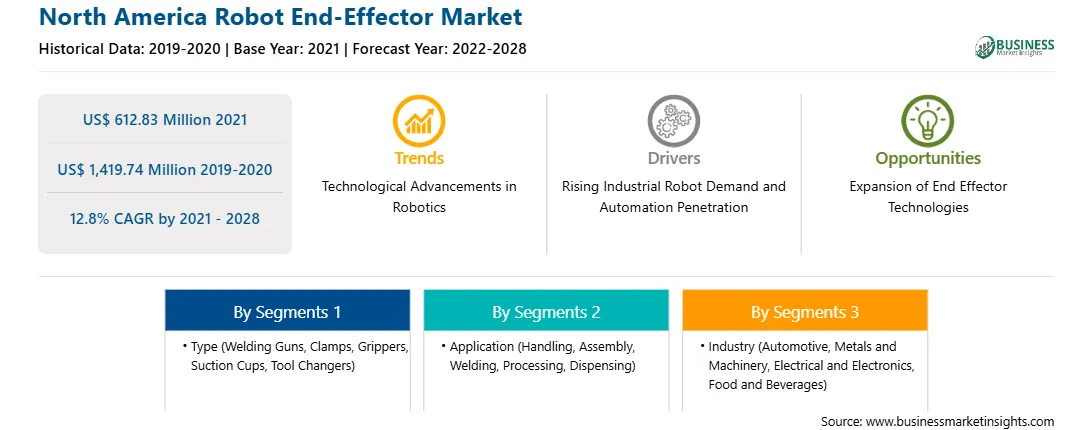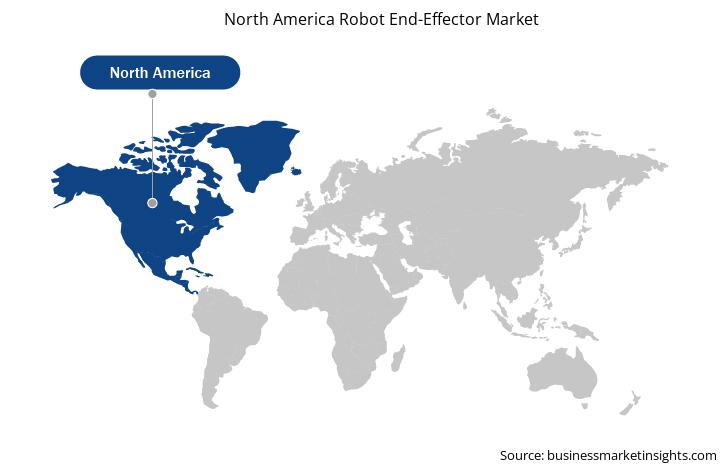At present, in the high-tech industry, the demand for innovative products is surging tremendously. The trend of reliable and effective devices, which can perform tasks faster and have lower production costs, is increasing in various verticals across the region. End-effector technology, which is considered as the business end of robots, is gaining immense popularity across the region. End-effector is attached to a wrist of a robot, which enables the robot to interact with its task. End-effectors can be electromechanical or mechanical and serve as sensors, grippers, and process tools. It is an essential part of a robot since, without it, most robots are practically useless. It uses various communication protocols and different programming interfaces and needs different levels of skills to operate effectively. The robot end-effector is used in various industries, including automotive, metal and machinery, electrical & electronics, food & beverages, and e-commerce. With the development of Industry 4.0, industrial operations are rising, leading to the popularity of robots for taking up complex tasks. Growing innovations in robotics are commencing an exponential growth of the robot end-effector market.
North America is one of the most important regions for adopting and developing new technologies due to favorable government policies to boost innovation, the presence of a huge industrial base, and high purchasing power, especially in developed countries such as the US and Canada. Hence, any impact on the growth of industries is expected to affect the region's economic growth negatively. COVID-19 has negatively impacted businesses in the region in four critical areas, such as supply chain/operations, workforce, 2020 investments, and product offering. In the first nine months, overhead costs, including expenses for sales, Research & Development (R&D), and administration of various providers fell adversely, due to severe measures taken in the course of the pandemic. Despite the effects of the North America outbreak, earnings were improved, primarily due to continuous optimization of the cost structure. COVID-19 has had a severe impact on transportation and automotive, and trade activity. North America is home to a large number of manufacturing and technology companies. Thus, the coronavirus outbreak's impact was quite severe in 2020 and likely in 2021 for the automotive and manufacturing sectors. The impact of COVID-19 is short-term; it is likely to decrease in the coming years.
With the new advancements and technologies, vendors can attract new customers and expand their footprints in emerging markets. This factor is likely to drive the North America robot end-effector market. Industrial robots play an important role in manufacturing industrial automation as several major operations in industries are being managed by robots. The governments in the region are taking initiatives to support and promote the development and adoption of industrial robots in their respective countries, which is surging its demand. For instance, as per the facts stated by the International Federation of Robotics (IFR), in 2017, the sales of industrial robots reached 387,000 units, increased by 31% compared to the previous year. US saw a increase in demand for industrial robots by 6%. The automotive industry witnessed massive demand for industrial robots, as in 2017, ~125,500 units were sold for the industry. The robust growth sectors in the same year were the metal, electrical/electronics, and food industries. The number of industrial robots continues to increase at an impressive pace in North America. Prime trends such as digitalization, simplification, and human-robot collaboration are shaping the future and propelling further swift development of next-generation robots. Thus, with strong growth in industrial robotics, manufacturers of robot end-effectors are gaining popularity, which is fueling the market growth.
Strategic insights for the North America Robot End-Effector provides data-driven analysis of the industry landscape, including current trends, key players, and regional nuances. These insights offer actionable recommendations, enabling readers to differentiate themselves from competitors by identifying untapped segments or developing unique value propositions. Leveraging data analytics, these insights help industry players anticipate the market shifts, whether investors, manufacturers, or other stakeholders. A future-oriented perspective is essential, helping stakeholders anticipate market shifts and position themselves for long-term success in this dynamic region. Ultimately, effective strategic insights empower readers to make informed decisions that drive profitability and achieve their business objectives within the market.

| Report Attribute | Details |
|---|---|
| Market size in 2021 | US$ 612.83 Million |
| Market Size by 2028 | US$ 1,419.74 Million |
| Global CAGR (2021 - 2028) | 12.8% |
| Historical Data | 2019-2020 |
| Forecast period | 2022-2028 |
| Segments Covered |
By Type
|
| Regions and Countries Covered | North America
|
| Market leaders and key company profiles |
The geographic scope of the North America Robot End-Effector refers to the specific areas in which a business operates and competes. Understanding local distinctions, such as diverse consumer preferences (e.g., demand for specific plug types or battery backup durations), varying economic conditions, and regulatory environments, is crucial for tailoring strategies to specific markets. Businesses can expand their reach by identifying underserved areas or adapting their offerings to meet local demands. A clear market focus allows for more effective resource allocation, targeted marketing campaigns, and better positioning against local competitors, ultimately driving growth in those targeted areas.

The North America Robot End-Effector Market is valued at US$ 612.83 Million in 2021, it is projected to reach US$ 1,419.74 Million by 2028.
As per our report North America Robot End-Effector Market, the market size is valued at US$ 612.83 Million in 2021, projecting it to reach US$ 1,419.74 Million by 2028. This translates to a CAGR of approximately 12.8% during the forecast period.
The North America Robot End-Effector Market report typically cover these key segments-
The historic period, base year, and forecast period can vary slightly depending on the specific market research report. However, for the North America Robot End-Effector Market report:
The North America Robot End-Effector Market is populated by several key players, each contributing to its growth and innovation. Some of the major players include:
The North America Robot End-Effector Market report is valuable for diverse stakeholders, including:
Essentially, anyone involved in or considering involvement in the North America Robot End-Effector Market value chain can benefit from the information contained in a comprehensive market report.